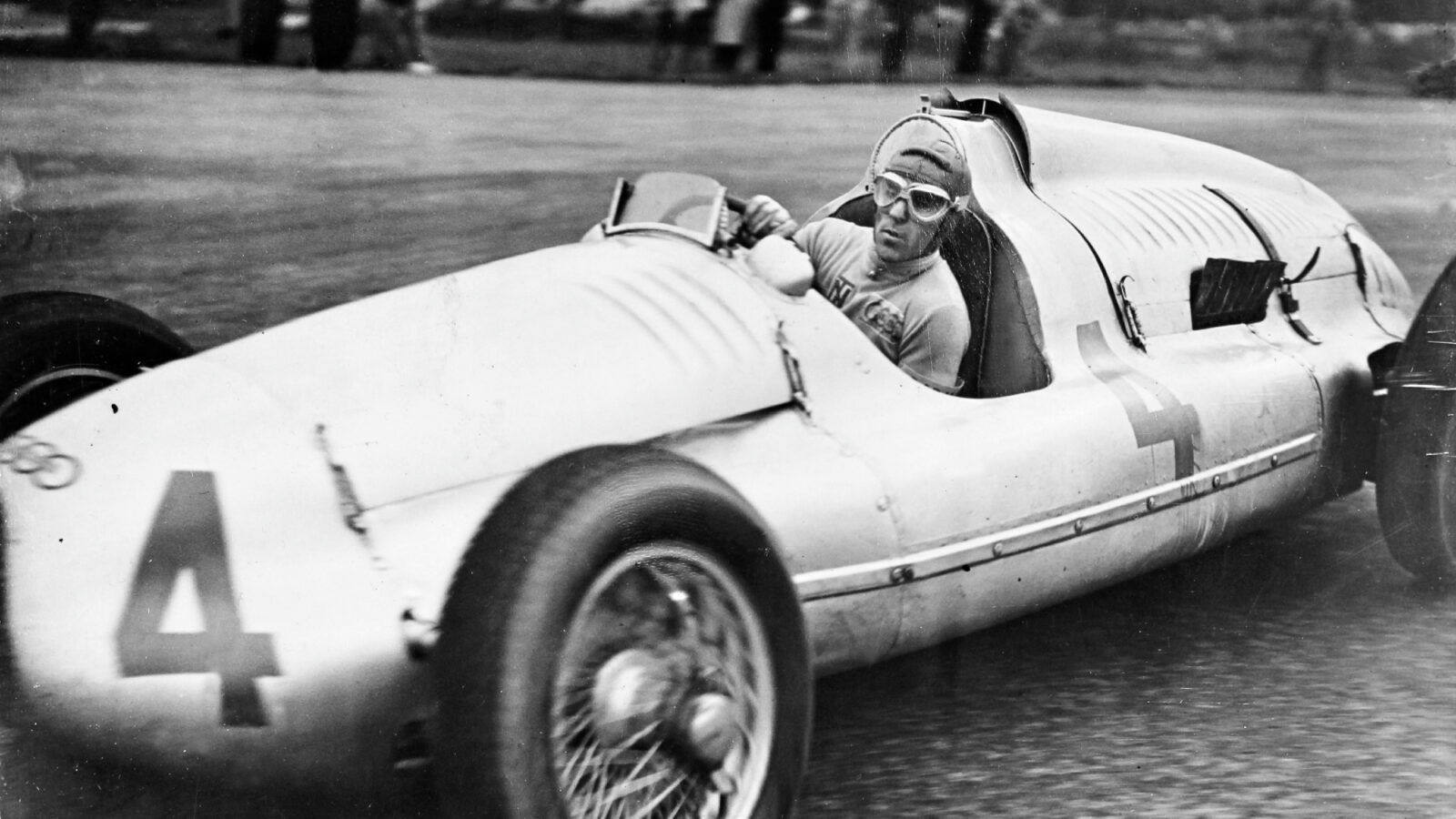October 22nd dawned misty and remained warm and gloriously sunny. H.R.H. the Duke of Kent flew up from London and was driven to the course in a V12 Lagonda saloon, in which Richard Seaman, mackintosh over his overalls, drove him for two laps of the course. The Duke, himself a fast driver of his 41-litre Bentley, started the race and walked to Coppice to watch the cornering before leaving the course, conducted round by Dr. Benjafield. The Duke attended the race in his capacity of President in Chief of the B.R.D.C. Reichsleiter Huhnlein was taken round the circuit by Lionel Martin in a Bentley and afterwards watched the race from the blue-and-gold decked Grandstand. After the finish Frau Huhnlein and the Reichsleiter presented the prizes. Capt. and Mrs. Bemrose and Mr. Shields were also present.
Members of the German Embassy drove up from London in open Mercedes-Benz and B.M.W. cars. Mercedes-Benz sent their Grosvenor Road engineering staff up by special coach, and a coachload of the R.A.F. also attended. Lots of aircraft brought visitors, including a wartime 504K Avro. And Donington had room for all of us, and all our cars, in comfort.
The field for this great race comprised : Tazio Nuvolari, Hermann Muller, Rudolf Hasse, and Christian Kautz with Formula Auto-Unions ; Hermann Lang, Manfred von Brauchitsch, Richard Beattie Seaman and Walter Baumer with Formula Mercedes-Benz, Villoresi with a Formula Maserati, Rene Dreyfus and Bodoignet Raph with Ecurie Bleue Delahayes, Arthur Dobson’s E.R.A., Ian Connell’s E.R.A., Billy Cotton’s E.R.A., Cuddon-Fletcher’s M.G., Percy Maclure’s Riley and Robin Hanson’s Alta.
Mercedes-Benz had put in Baumer because Rudolf Caracciola had a damaged foot and had not come over. Auto-Union had Ulrich Bigalke as reserve driver. The Mercedes-Benz cars have 60° V12 engines of 2,962 c.c., with four valves per cylinder operated by four o.h. camshafts. Twin Roots blowers suck from Mercedes carburetters and the solid crankshaft runs in split roller bearings. The cylinder blocks are of alloy, with steel liners and the crankcase is also of light alloy. The camshafts are driven from the rear end. At the rear end also are twin Bosch magnetos. The engines peak at around 7,500 r.p.m., and give off 400 to 450 b.h.p. There is an oil-tank in the crankcase and the fuel storage comprises two separate tanks coupled by large-bore pipes, one in the tail and one as a saddle round the scuttle. The front tank fills first and the combined capacity is approximately 70 gallons. The latest tankage ensures that weight distribution remains correct at all levels.
The chassis has alloy oval side members braced by four tubular cross-members. Transmission is via a single dry-plate clutch and off-set propeller shaft to a five speed and reverse gem box mounted on the frame and controlled by right hand lever. Suspension at the rear is by torsion bars parallel with the side-members, controlled by hydraulic shock-absorbers adjustable from the cockpit. The jointed’ driving shafts are tied by a De Dion type tubular axle. Front suspension is independent, by pressed steel wishbones and coil springs with four coils, controlled by hydraulic shock-absorbers. Separate steering drag-links are used. Lockheed hydraulic braking is used. The exhaust-pipes have been brought outside the body for recent races and some cars now have stubby tails. The average weight is approximately 978 kilos., hut it is said. that the ears are now lighter. They consume fuel at under 2 m.p.g. For Donington 7.00″ x 19° rear covers were used. The Mercedes-Benz team is under the control of Herr Alfred Neubauer and their head engineer is Herr Uhlenhaut, who committed lots of practice lappery at Donington. The head mechanics are Zimmer and Lindenmaier.
Geier is a timekeeper. Dr. Glesser is medical adviser to ‘both teams. The Auto-Unions have rear-placed V12 engines of 2,986 c.c., with overhead valves actuated by three o.h. camshafts and a single Roots blower driven from the rear of the engine and sucking from twin carburetters. Light alloy construction is used throughout. Tubular openwork frame side members are used, and through them the cooling water circulates from engine to radiator. The transmission incorporates a five speed gearbox mounted on the rear axle. Front suspension is independent, by torsion bar, and at the rear a De Dion axle is sprung by torsion bar, hydraulically damped. Lockheed hydraulic brakes are used and the driver sits ahead of the engine. The Auto-Union equipe is governed by Dr. Feureissen. The head technician is Robert Eberon von Eberhorst, who speaks English, and his chief assistant is Sebastian. Nuvolari brought his personal mechanic.





